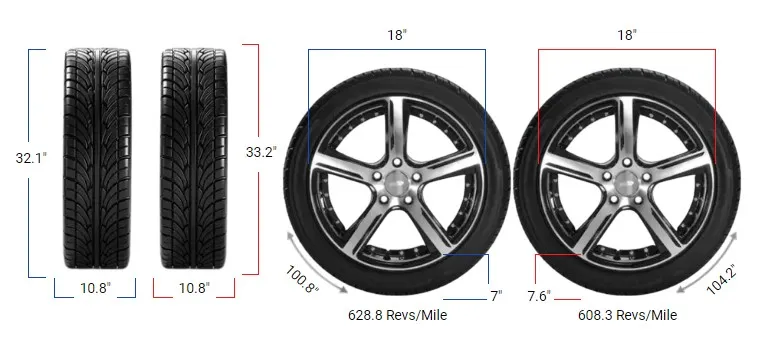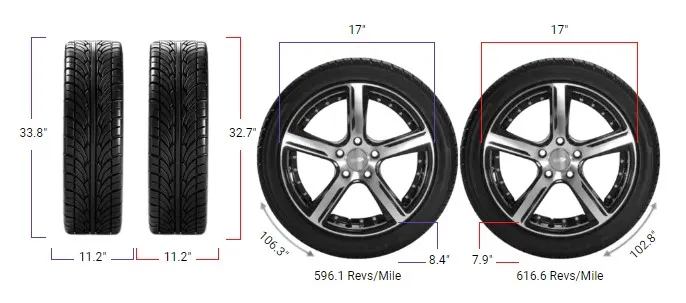Tire Size 255/70r16 vs 265/70r16

Are you considering upgrading your 255/70r16 tires to a slightly larger 265/70r16 size? While the differences may seem minor, it’s important to understand the implications before making the switch.
- Slightly improved traction and stability, especially in off-road conditions
- Marginally smoother ride due to increased air volume in the tires
- Enhanced rugged appearance with a more aggressive stance
- Minor increase in ground clearance for better off-road performance
- Potential for slightly reduced fuel efficiency compared to narrower tires

Fitment Guide
In this case, the diameter difference between 255/70r16 and 265/70r16 tires is 1.8%, which falls within the acceptable range.
However, if the difference exceeds 3%, it’s not recommended to make the switch without necessary adaptations to prevent rubbing or clearance issues.
On-Road Impact
Switching to a different tire size can influence several aspects of your vehicle’s on-road performance. Understanding these impacts can help you make an informed decision.
Gas Mileage
A wider tire increases the surface area in contact with the road, which can lead to higher rolling resistance. This might result in a slight decrease in fuel efficiency, possibly around 1-2%.
However, given the minimal size difference—only 0.39 inches (10 mm) in width—the impact on gas mileage is likely to be negligible for most drivers. Factors such as driving habits and vehicle maintenance often have a more significant effect on fuel consumption.

Ride Comfort
The 265/70r16 has a slightly taller sidewall height of 7.3 inches compared to 7.03 inches on the 255/70r16.
This additional cushioning can enhance ride comfort by absorbing more road vibrations and bumps, providing a smoother driving experience, especially on rough or uneven pavement.
The increased sidewall flex can also contribute to a more forgiving ride over potholes and road imperfections.
Speedometer Accuracy
With the increase in tire diameter, your speedometer will read slightly lower than your actual speed. Specifically, when your speedometer reads 60 mph, your actual speed would be approximately 61.08 mph due to the 1.8% increase in tire circumference.
While this discrepancy is minor, it’s important to be aware of it to avoid unintended speeding, particularly in areas with strict speed enforcement.
Aesthetic Look
Upgrading to the 265/70r16 can give your vehicle a more aggressive and robust appearance. The larger tires fill out the wheel wells more completely, enhancing the overall aesthetic appeal.
This can be particularly appealing for SUVs and trucks, adding to their rugged image. Additionally, the improved stance may increase the vehicle’s presence on the road, potentially contributing to a perception of increased stability and capability.

Handling and Stability
The wider tire footprint can improve road grip, enhancing handling and stability, especially during cornering and braking.
The increased contact area with the road surface can lead to better traction, reducing the likelihood of slippage under acceleration or in wet conditions.
This can contribute to a safer driving experience under various road conditions, providing drivers with increased confidence behind the wheel.
Braking Performance
A larger contact patch can improve braking performance by allowing the tire to grip the road more effectively during deceleration. This can lead to shorter stopping distances, which is a significant safety advantage. However, it’s important to ensure that your braking system is properly maintained to fully capitalize on this benefit.
Noise Levels
Wider tires can sometimes produce more road noise due to the increased surface area and tread patterns.
However, the difference between the 255/70r16 and the 265/70r16 is minimal, and most drivers are unlikely to notice a significant change in cabin noise levels.
Off-Road Impact
For those who venture off the beaten path, tire size can significantly affect off-road performance. Here’s how the switch impacts your off-road adventures.
Ground Clearance
The slight increase in tire diameter provides an extra 0.28 inches of ground clearance. While this may seem minimal, it can make a noticeable difference when navigating over rocks, logs, or uneven terrain.
This additional clearance reduces the risk of undercarriage damage and can improve the vehicle’s ability to tackle more challenging off-road obstacles.
Traction
A wider tire offers a larger contact patch with the ground, enhancing traction on challenging surfaces like mud, sand, and gravel.
This improved traction can help prevent the vehicle from getting stuck and can enhance control when maneuvering through difficult terrain. The additional width also allows for better flotation over soft surfaces, reducing the likelihood of sinking.
Vehicle Capability
The enhanced ground clearance and improved traction collectively boost your vehicle’s off-road capability. You may find it easier to tackle steeper inclines and more rugged trails without the need for additional modifications.
The increased tire size can also improve approach and departure angles slightly, contributing to better off-road performance.
Durability & Wear
Off-road driving can be tough on tires. The 265/70r16’s larger size may distribute stress more evenly across the tire surface, potentially extending tread life under harsh conditions.
Additionally, the increased sidewall height can offer better protection against punctures and sidewall damage from rocks and debris.
Tire Pressure Considerations
When off-roading, it’s common practice to adjust tire pressure for better traction. The 265/70r16’s larger volume allows for more flexibility in adjusting air pressure without compromising the tire’s structural integrity.
This can enhance performance in various off-road conditions, such as sand or mud, where lower tire pressure can improve grip.
255/70r16 vs 265/70r16
This table compares the key specifications of tire sizes 255/70R16 and 265/75R16.
| Feature | 255/70R16 | 265/75R16 | Difference |
|---|---|---|---|
| Diameter inches (mm) | 30.06 (763.4) | 31.65 (803.9) | 1.59 (40.5) 5.3% |
| Width inches (mm) | 10.04 (255) | 10.43 (265) | 0.39 (10) 3.9% |
| Circumference inches (mm) | 94.42 (2398.29) | 99.43 (2525.53) | 5.01 (127.23) 5.3% |
| Sidewall Height (mm) | 7.03 (178.5) | 7.82 (198.75) | 0.79 (20.25) 11.3% |
| Revolutions per mile (km) | 671.04 (416.96) | 637.23 (395.96) | -33.81 (-21.01) -5% |
| Speedo Reading | 20 mph | 21.06 mph | +1.06 mph |
Difference Between 255/70r16 and 265/70r16
The main difference between 255/70r16 and 265/70r16 tires is their width. The 265/70r16 tires are 0.39 inches (10 mm) wider than the 255/70r16 tires.
Can I Use 265/70r16 Instead of 255/70r16?
Yes, you can use 265/70r16 tires instead of 255/70r16 tires because the diameter difference is within the acceptable ±3% range. However, minor performance differences may occur.
How Much Taller Is a 265/70r16 Tire Than a 255/70r16?
A 265/70r16 tire is approximately 0.55 inches (14 mm) taller than a 255/70r16 tire. The overall diameter of the 265/70r16 tire is 30.61 inches, compared to 30.06 inches for the 255/70r16 tire.
How Much Wider is a 265/70r16 Tire Than a 255/70r16?
A 265/70r16 tire is 0.39 inches (10 mm) wider than a 255/70r16 tire. The 265/70r16 tire has a width of 10.43 inches, while the 255/70r16 tire has a width of 10.04 inches.
Our Observation
Switching from 255/70r16 to 265/70r16 offers several benefits, including improved traction, a marginal increase in ground clearance, and a more robust aesthetic appeal. On-road, drivers may experience enhanced handling, better braking performance, and a smoother ride, with only minimal impacts on fuel efficiency and speedometer accuracy. The aesthetic enhancement adds to the vehicle’s appeal without compromising functionality.
Off-road, the advantages are more pronounced. The increased ground clearance and wider tread improve the vehicle’s ability to handle challenging terrains. Enhanced traction, better flotation over soft surfaces, and improved durability contribute to a more capable and reliable off-road experience. The flexibility in tire pressure adjustments further enhances off-road performance.
The drawbacks are relatively minor and often negligible. The slight decrease in fuel efficiency and the minor speedometer discrepancy are unlikely to significantly affect most drivers. Potential issues with tire clearance are minimal but should be checked to ensure no rubbing occurs. Given that the size difference is within the acceptable fitment guidelines, the switch doesn’t necessitate major adjustments or raise significant safety concerns.
Overall, transitioning to the 265/70r16 tire size is a viable option for those seeking to enhance both the on-road and off-road performance of their vehicle without compromising safety or incurring substantial costs. The benefits appear to outweigh the minor drawbacks, making this upgrade a worthwhile consideration for many drivers.



